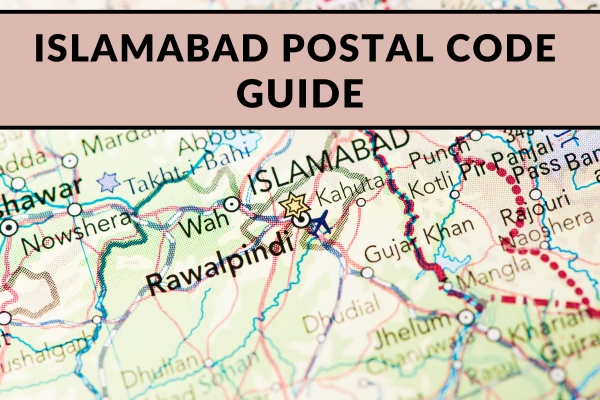Ever tried sending a letter or ordering online and got stuck at the postal code field? The right Islamabad postal code isn’t just a small box to fill; it holds the key to smooth mail delivery, fast service, and hassle-free navigation. Islamabad, the green and orderly capital city of Pakistan, has its own unique system for postal codes. Knowing it can save time, avoid confusion, and even help businesses reach customers without a hitch.
So if you’re a resident, business owner, student, or just curious, here’s your comprehensive guide to Islamabad postal codes—what they are, how they work, and how to use them every day.
Understanding the Islamabad Postal Code System
A postal code is like a map pin, pointing to the exact spot where a letter or package should go. In Islamabad, these codes help sort the city into neat zones for everything from home deliveries to government paperwork.
The city’s layout is based on sectors, each with its own separate code. This system helps post offices, couriers, and even digital services work reliably and fast. For official forms, online orders, or finding the right building in a maze of similar streets, the Islamabad postal code spells the difference between easy success and lost mail.
General Format of Islamabad Postal Codes
Islamabad’s postal codes are five digits long. They start with “44” and end with three more digits specific to each area or sector. This format is different from other cities—for example, Lahore starts with “54” and Karachi with “75.”
Here’s how it breaks down:
- Islamabad postal codes: Begin with 44 (examples: 44000, 44010)
- Other city codes: Vary based on location (e.g., Lahore: 54000, Karachi: 74600)
Each sector, area, or institution in Islamabad has its own unique code. So even a small typo or mix-up can mean your mail ends up in the wrong place.
Purpose and Uses of Islamabad Postal Codes
Why care about the right Islamabad postal code? It comes down to convenience, security, and efficiency:
- Mail delivery: Post offices sort letters and parcels using postal codes for quick and accurate delivery.
- Identity checks: Many government offices and banks use postal codes to verify addresses.
- Online shopping: E-commerce sites depend on postal codes to find your location for delivery.
- Mapping and GPS: Navigation apps use these codes to guide users straight to a doorstep.
- Records and documentation: Schools, hospitals, and businesses include postal codes in their official records to avoid confusion.
List of Key Islamabad Postal Codes by Area
Islamabad is divided into a grid of sectors (F, G, I, H, etc.), and each sector gets its own postal code. There are special codes for government offices, universities, hospitals, and even huge markets. Knowing these codes helps with everything from writing the perfect address to getting fast deliveries.
Sector-wise Postal Codes in Islamabad
Each sector consists of smaller neighborhoods and public buildings, but here are the main ones you’re most likely to need:
- F Sectors:
- F-6: 44010
- F-7: 44030
- F-8: 44080
- F-10: 44000
- G Sectors:
- G-5: 44000 (also the main code for central government offices)
- G-6: 44020
- G-7: 44030
- G-8: 44080
- G-10: 44070
- G-11: 44090
- G-13: 44080
- H Sectors:
- H-8: 44090
- H-9: 44090
- I Sectors:
- I-8: 44800
- I-9: 44800
- I-10: 44800
- I-11: 44810
- Commercial and Business Hubs:
- Blue Area (Business district): 44000
- Aabpara: 44010
- Suburban and Newer Areas:
- DHA Islamabad: 45710
- Bahria Town: 46220
These codes give each sector and area its own identity for sorting and communication. Residential codes differ from those assigned to huge government or business spaces.
Postal Codes for Notable Landmarks and Institutions
Islamabad is home to key places that everyone in Pakistan recognizes. Here are a few you might need to know:
- Parliament House: 44000
- Supreme Court of Pakistan: 44000
- Pakistan Secretariat: 44010
- Allama Iqbal Open University: 44000
- Quaid-i-Azam University: 45320
- Pakistan Institute of Medical Sciences (PIMS): 44000
- Foreign Embassies (Diplomatic Enclave): 44000
- Pakistan Post Head Office: 44060
If you’re sending documents, applying for admissions, or arranging service appointments, use the exact postal code for the institution. This avoids missing or delayed correspondence.
How to Find or Verify a Postal Code in Islamabad
It’s easy to find the right Islamabad postal code if you know where to look. Here’s how you can do it:
- Check Pakistan Post official website: They keep an updated list of every area and its postal code.
- Ask at your nearest post office: Staff at local post offices are trained to help.
- Look at utility bills or bank statements: Official documents often list your postal code under your address.
- Use online maps and navigation apps: Most apps, like Google Maps, will show the postal code for typed addresses.
- Double-check when shopping online: Entering the wrong code may lead to delays or wrong deliveries.
Common mistakes to avoid:
- Mixing up sector names or numbers (F-6 vs. F-7).
- Using postal codes from nearby cities like Rawalpindi.
- Leaving the postal code field blank.
Always use the verified postal code—especially for official forms, job applications, and online orders. It keeps your information accurate and helps avoid headaches later on.
A postal code isn’t just a detail—it’s the key to smooth communication, reliable deliveries, and accurate records in Islamabad. Whether you’re sending a letter to G-10, shipping packages to Bahria Town, or visiting a major embassy, the right Islamabad postal code gets your task done right the first time.
Keep this guide handy when writing addresses, filling out forms, or shopping online. The next time you wonder about a postal code, just check this list and watch your tasks become much easier.



